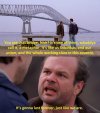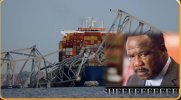They'll obviously open the port as soon as they can economically, but they'll have to clear the mess out of the way first, that'll probably need a salvage company. The ship will likely need refloating, it could be badly damaged under the water, then they'll have to do some serious checks under the water to make sure the channel is still viable, it may need dredging after several days/weeks with no ship movements as its tidal, so every 6 hours, water and sediment move back and forth, I don't know what the tidal spread is.
On the bridge rebuild, they'll still have the concrete piers to build on, so that could help.




